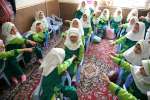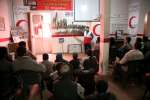Refugees Magazine Issue 108 (Afghanistan : the unending crisis) - Gifts from Japan
Refugees Magazine, 1 June 1997
Many Afghan child refugees have never had a gift in their lives. Japanese girl scouts are bringing a little joy to their lives.
By Veslemoy Naerland
The little Afghan girl said she had never owned a toy in her life. Now she was happily skipping a rope for the first time. Other Afghan refugee children excitedly unwrapped presents containing inexpensive pencils, crayons and notebooks. Girls weaved ribbons through their hair and proudly wore them for weeks afterwards. They may have cost very little, but the gifts were the most precious objects these children have ever owned.
Aid for Afghanistan comes in many forms. One of the most unusual, and touching, is the annual visit to the region by members of the Japanese girl scout movement as part of the worldwide peace pack programme launched jointly by UNHCR and the World Association of Girl Guides and Girl Scouts in 1993. Since then, girls in 52 countries have collected more than 260,000 packs for refugee children around the world.
The Japanese movement concentrated on Afghanistan. In 1995 and 1996, the peace packs were distributed directly to children inside Afghanistan, as well as in Pakistan. This year, because of the continuing civil war and political instability, they have so far only been distributed in Pakistan's North-West Frontier Province (NWFP).
Fifty thousand Japanese girls had spent the previous year collecting 13,536 packages. In March, a delegation of six Japanese Girl Scout leaders and their trainer inaugurated the distribution of the first of the packages in the city of Peshawar and the rural Dir district bordering Afghanistan. It is hoped the distribution can be completed inside Afghanistan later this year if the situation there stabilizes and schools, especially for girls, reopen.
The peace packs included educational materials such as pencils, notebooks, erasers and rulers and other items such as toys, T-shirts and toiletries. Each group of items had a particular importance. Most children in less developed countries, especially refugees, are desperately keen to receive an education and the crayons and rulers stressed the importance of schooling to parents, teachers and children alike. The other items were pure luxury. Few of the children had ever owned a bar of soap or a toothbrush in their lives.
For one day, as the Japanese girls handed out their gifts, the children became the focus of attention of the whole village, enjoying what for them was the first brush with luxury in their lives. Teachers watched startled as their normally subdued and shy pupils burst into spontaneous song. As a morale booster, and an important and practical addition to the lives of the refugees, "the value of these packs is impossible to quantify," said one teacher at a girl's school in Dir.
Source: Refugees Magazine issue 108 (1997)
















































